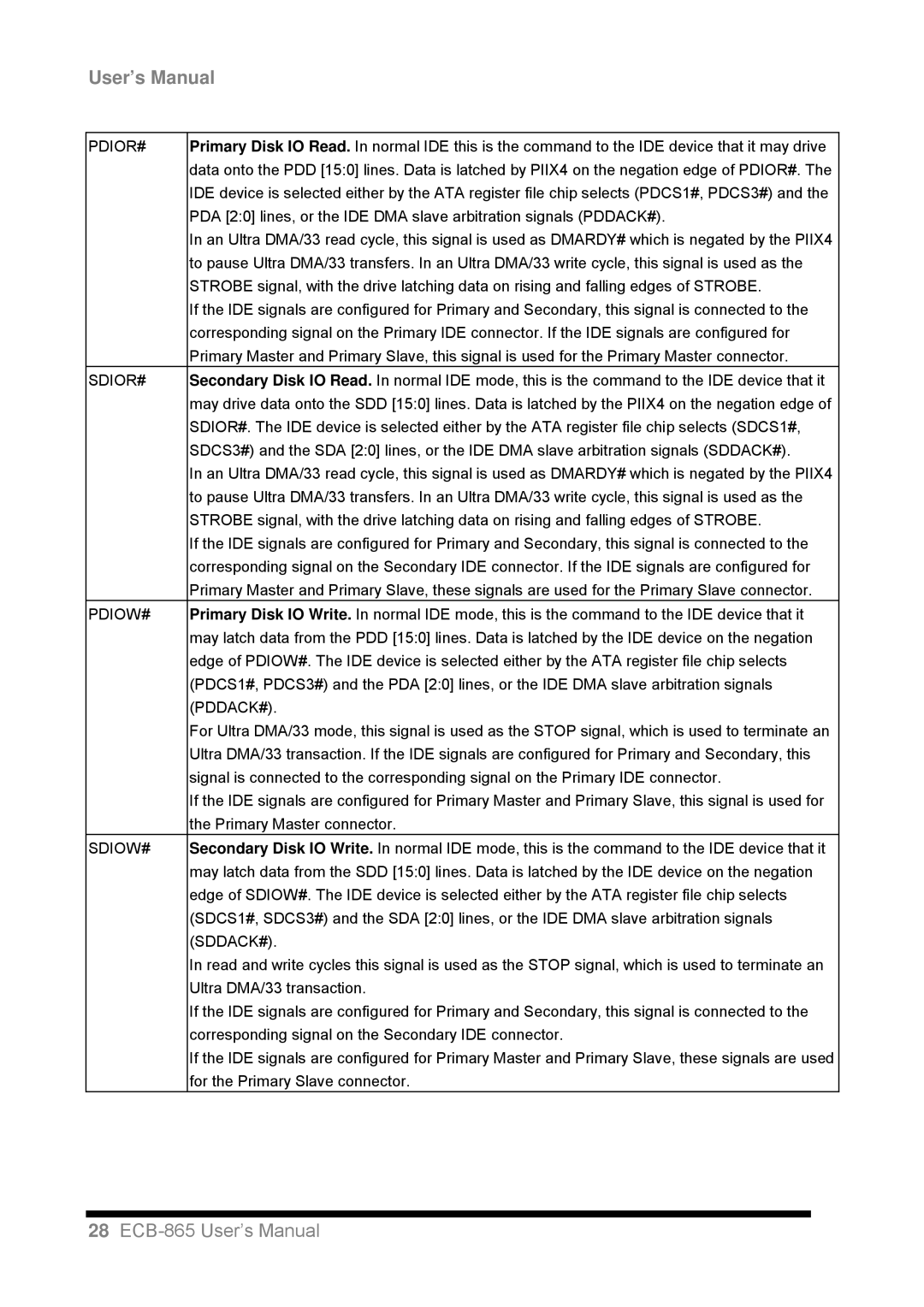User’s Manual
PDIOR# | Primary Disk IO Read. In normal IDE this is the command to the IDE device that it may drive |
| data onto the PDD [15:0] lines. Data is latched by PIIX4 on the negation edge of PDIOR#. The |
| IDE device is selected either by the ATA register file chip selects (PDCS1#, PDCS3#) and the |
| PDA [2:0] lines, or the IDE DMA slave arbitration signals (PDDACK#). |
| In an Ultra DMA/33 read cycle, this signal is used as DMARDY# which is negated by the PIIX4 |
| to pause Ultra DMA/33 transfers. In an Ultra DMA/33 write cycle, this signal is used as the |
| STROBE signal, with the drive latching data on rising and falling edges of STROBE. |
| If the IDE signals are configured for Primary and Secondary, this signal is connected to the |
| corresponding signal on the Primary IDE connector. If the IDE signals are configured for |
| Primary Master and Primary Slave, this signal is used for the Primary Master connector. |
SDIOR# | Secondary Disk IO Read. In normal IDE mode, this is the command to the IDE device that it |
| may drive data onto the SDD [15:0] lines. Data is latched by the PIIX4 on the negation edge of |
| SDIOR#. The IDE device is selected either by the ATA register file chip selects (SDCS1#, |
| SDCS3#) and the SDA [2:0] lines, or the IDE DMA slave arbitration signals (SDDACK#). |
| In an Ultra DMA/33 read cycle, this signal is used as DMARDY# which is negated by the PIIX4 |
| to pause Ultra DMA/33 transfers. In an Ultra DMA/33 write cycle, this signal is used as the |
| STROBE signal, with the drive latching data on rising and falling edges of STROBE. |
| If the IDE signals are configured for Primary and Secondary, this signal is connected to the |
| corresponding signal on the Secondary IDE connector. If the IDE signals are configured for |
| Primary Master and Primary Slave, these signals are used for the Primary Slave connector. |
PDIOW# | Primary Disk IO Write. In normal IDE mode, this is the command to the IDE device that it |
| may latch data from the PDD [15:0] lines. Data is latched by the IDE device on the negation |
| edge of PDIOW#. The IDE device is selected either by the ATA register file chip selects |
| (PDCS1#, PDCS3#) and the PDA [2:0] lines, or the IDE DMA slave arbitration signals |
| (PDDACK#). |
| For Ultra DMA/33 mode, this signal is used as the STOP signal, which is used to terminate an |
| Ultra DMA/33 transaction. If the IDE signals are configured for Primary and Secondary, this |
| signal is connected to the corresponding signal on the Primary IDE connector. |
| If the IDE signals are configured for Primary Master and Primary Slave, this signal is used for |
| the Primary Master connector. |
SDIOW# | Secondary Disk IO Write. In normal IDE mode, this is the command to the IDE device that it |
| may latch data from the SDD [15:0] lines. Data is latched by the IDE device on the negation |
| edge of SDIOW#. The IDE device is selected either by the ATA register file chip selects |
| (SDCS1#, SDCS3#) and the SDA [2:0] lines, or the IDE DMA slave arbitration signals |
| (SDDACK#). |
| In read and write cycles this signal is used as the STOP signal, which is used to terminate an |
| Ultra DMA/33 transaction. |
| If the IDE signals are configured for Primary and Secondary, this signal is connected to the |
| corresponding signal on the Secondary IDE connector. |
| If the IDE signals are configured for Primary Master and Primary Slave, these signals are used |
| for the Primary Slave connector. |
28
